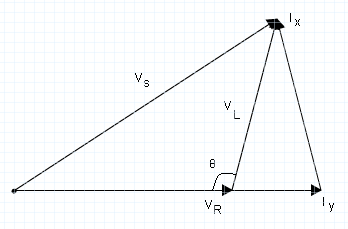3-Voltmeter Method of Measuring Choke Coil Parameters:-
The choke coil parameters we are going to measure in this 3-voltmeter method are – the inductance, resistance as all choke coils have inherent resistance in addition to their inductance. We also measure the quality factor and power absorbed by the given choke coil.
A given choke coil is usually represented by a pure inductance (L) in series with equivalent resistance (r). This equivalent resistance takes into effect the iron losses in the core of the choke coil and the inherent resistance of the choke coil. 3-Voltmeter method and 3-Ammeter method are two of the best ways to measure these two parameters. Thus the equivalent resistance accounts for the copper loses in the choke coil and the iron loses in the iron core.
The following figures represent the circuit diagram of 3-voltmeter, equivalent circuit of choke coil.
Supply voltage ‘Vs‘ can be varied by means of the single phase variac. VR and VL are the voltmeter readings across the resistance and choke coil. The phasor diagram for the measurement of choke coil parameters by 3-voltmeter method is as shown below :
From the phasor diagram it is clear that,
Procedure for 3-voltmeter method of finding choke coil parameters :-
- Give the connections as in the circuit diagram.
- Apply 230V, 1-φ A.C voltage by means of 1-φ A.C variac to the series combination of choke coil and external resistance.
- Note down the readings of the 3 voltmeters.
- Apply different voltages in suitable steps and note down the readings of voltmeter.
- Calculate coil resistance, inductance and Q-factor using the above mentioned formulae.




Good…helpful
Excellent presentation
thanks a lot for your information
I missed my lectures and was in great need of the 3-Voltmeter method and 3-Ammeter method notes. I must say that the article is excellent and the representation is too good. It is very beneficial for the students.
thanks a lot for your information,
good presentation